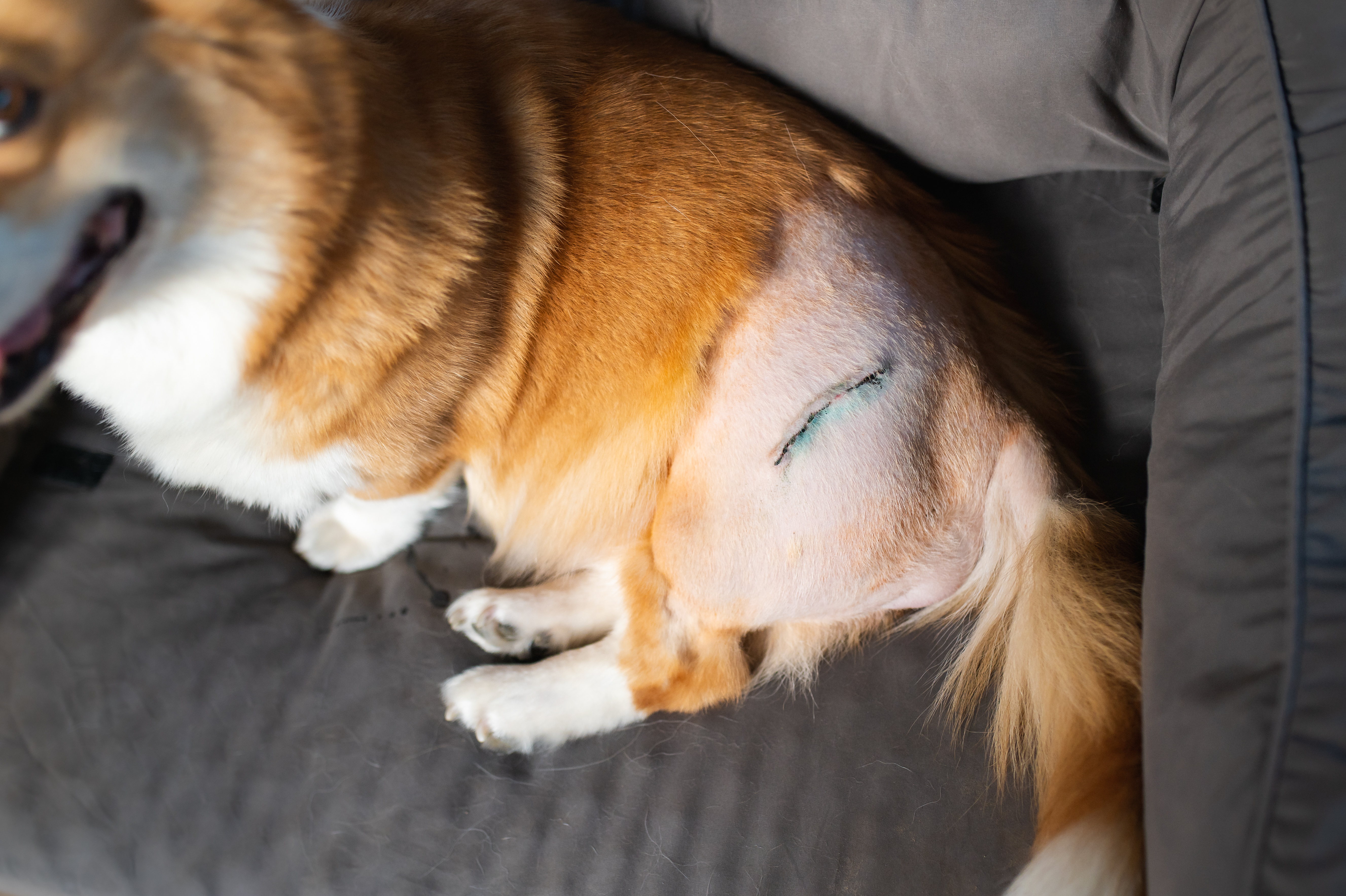AdobeStock_636469552.jpeg

Corgi with a freshly shaved leg after hip surgery.
Deciding how best to treat a dog diagnosed with hip dysplasia can be complicated. Because there are so many variables and no one-size-fits-all solutions, treatment advice is often best given by a specialist in orthopedic surgery. Your veterinarian can refer you to a veterinary orthopedic surgeon.
Prevention and Treatment Factors To Consider
Issues to think about when considering treatment of hip dysplasia include:
- When to begin treatment
- Dog’s age
- Current signs (if any) and anticipated future signs
- Intended activities for the dog
- X-ray findings
- Current diseases or injuries
- Dog’s temperament
- The owner’s ability to manage their dog after a surgical procedure
- Financial considerations
Treatment approaches can be divided into prophylactic (preventative) or therapeutic (treatment of and continued care for active signs) approaches. Other than careful screening of potential parents and selective breeding, there are few options for controlling an offspring's phenotype (observable traits).
There are a few main areas to consider when considering the environmental factors that might contribute to a patient’s phenotype.
Nutritional Factors
Overfeeding and overly-rich diets have been shown to increase the risk of hip dysplasia. Although owners of large-breed puppies want to see their dogs grow to the largest possible size, their final adult size is largely determined by genetics. Very poor nutrition could stunt growth, but overfeeding or feeding overly rich foods only results in more rapid attainment of that final adult size.
Rapid growth is a risk factor for hip dysplasia and several other orthopedic diseases. Special diets developed for large breed growth are probably the best choice.
Excess weight can cause increased signs in patients with mechanical lameness or osteoarthritis, so keeping dogs with hip dysplasia on the leaner side is often helpful for controlling signs.
Hormonal Factors
The hormones testosterone and estrogen play a role in bone growth. If a dog is spayed or castrated before bone growth is complete, the surgery is expected to have some impact on its development.
Lack of testosterone in male puppies results in delayed maturing of the skeleton, so male dogs castrated as puppies tend to have longer bones and grow a bit taller.
Evidence shows that similar changes occur in bone growth in female puppies that are spayed at a too-young age. Dogs castrated before 5.5 months of age have a slightly higher incidence of hip dysplasia than those spayed or castrated after 5.5 months.
Exercise
In dogs with hip osteoarthritis, the best approach is to have regular, moderate activity and avoid being too inactive or too physical. Climbing stairs has been shown to be a risk factor in puppies under three months old. No convincing studies show the amount or type of other activities a puppy engages in affects the development of hip dysplasia.
Because little can be done to prevent hip dysplasia in dogs genetically inclined to the disease, most treatment focuses on dogs with the disease already present.
canine_hip_normal_cms_resizeto_320x600.20240717013 - Caption. [Optional]
![canine_hip_normal_cms_resizeto_320x600.20240717013 - Caption. [Optional] X-rays of normal canine hips](/AppUtil/Image/handler.ashx?imgid=8442653)
Treatment Options
Treatment options are divided into the following: medical (non-surgical) or surgical.
The most important rule of thumb for dog owners and veterinarians is to “treat the patient and not the X-rays.” No matter how bad a dog’s hip might feel or how it looks on an X-ray, it may not require medical or surgical treatment unless there are signs of discomfort, lameness, or decreased athletic ability.
Medical Management
Medical management is usually tried before surgery is considered and can include such things as:
- Nutraceuticals (joint supplements)
- Analgesics (pain medicines), anti-inflammatories
- Acupuncture
- Physical therapy
- Herbal remedies
- Laser treatments
- Shock wave therapy
- Joint injections
- Stem cells, other so-called “biologic therapies”
- Weight control
Medical management is the first line of treatment for dogs with hip pain or evidence of osteoarthritis and may be all that is needed. Some of these supplements or treatments have good supporting evidence for their usefulness, while others lack such convincing evidence. Except for treating certain young dogs with surgery designed to improve hip mechanics before arthritis sets in, medical management is usually tried before any consideration is given to surgery.
Surgery
Treatments can help control the signs of the arthritic condition but won’t stop the underlying condition. If this approach fails, then surgery is considered.
If your veterinarian recommends a surgical consultation with an orthopedic specialist for your dog, the surgeon will explain the type of surgery recommended and the intended outcome.
Prognosis and Conclusions
Although no one wants to have a dog with lameness problems, and though some lamenesses are due to hip dysplasia, the diagnosis of a dog being dysplastic is not a reason for panic or dread.
Many dogs with some degree of hip dysplasia can be asymptomatic (having no signs) for some or even all their lives. Treatment options are available at every stage of a dog’s life to manage hip dysplasia medically or surgically and to allow your dog to enjoy a pain-free, active lifestyle.
Preventing hip dysplasia lies mostly with breeders doing a reputable job of screening potential parents and striving to only breed dogs with the best quality hips, understanding that, lacking a genetic test to guide breeding decisions, even pedigrees with no history of hip dysplasia have the potential to produce offspring with the unfortunate combination of genes that predispose to looser hips.
Proper nutrition during growth may help lessen the expression of genes responsible for hip laxity.
Key takeaways for owners include understanding that not all hind-end lameness or pain problems are due to bad hips (even if X-rays reveal hip dysplasia and arthritis), and that symptomatic hip dysplasia with arthritis is often problematic in its onset, waxes and wanes, and may be misinterpreted as an aging problem rather than a treatable orthopedic problem.
Please see: Hip Dysplasia in Dogs - Background, Signs and Diagnosis